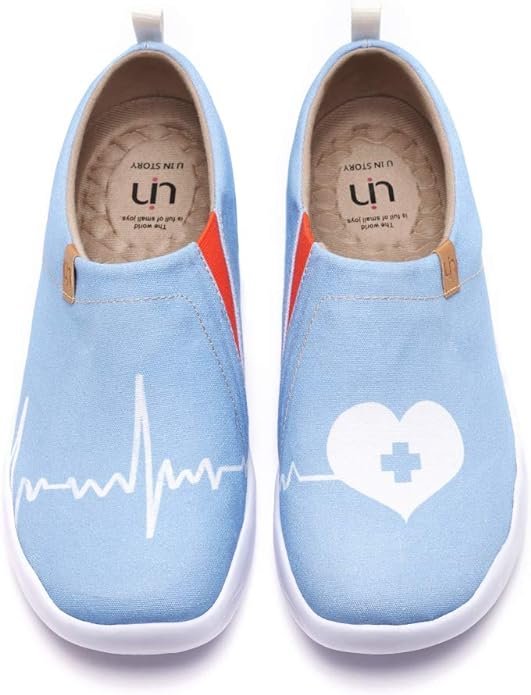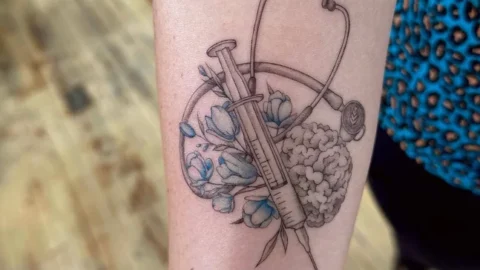Choosing the right shoes is crucial for nurses, especially those with flat feet. Nurses are on their feet for long hours, and footwear that provides the right support and comfort can make a significant difference in their workday. Shoes designed to accommodate flat feet help in maintaining proper posture and preventing foot pain and other related issues.

Finding the best shoes for nurses with flat feet involves looking for features such as strong arch support, cushioning, and stability. These elements work together to reduce the strain on the feet throughout long shifts. A variety of options exist, catering not only to the health and safety requirements of nursing professionals but also to their style preferences.
Insights from experts, combined with user experiences, suggest that the best nursing shoes for those with flat feet incorporate a balance of function and comfort. The 9 Best Shoes for Nurses of 2023, Tested and Reviewed provides guidance on what to look for in nursing shoes. Additionally, those seeking options tailored to their needs can consider 16 Best Nursing Shoes For Flat Feet for recommendations based on the latest market offerings.
Importance of Proper Footwear for Nurses with Flat Feet

Nurses with flat feet often experience discomfort and stress on their feet due to long hours of standing and walking. Flat feet lack a natural arch, which can lead to overpronation and an uneven distribution of body weight. This increases the risk of foot pain and other related conditions such as plantar fasciitis.
Proper footwear is essential for nurses with flat feet as it provides:
- Arch Support: Quality nursing shoes offer adequate arch support that compensates for the lack of a natural arch, reducing strain on the midfoot.
- Stability: Shoes with good stability control overpronation, helping to align the feet and reduce the risk of injury.
The features of Optimal Nursing Shoes for Flat Feet include:
- Gel Cushioning: Minimizes impact on the heels during long shifts.
- Supportive Midsole: Helps in energy retention and bounce-back, vital for nurses who are constantly on the move.
- Structured Heel Counter: Ensures a secure and snug fit, preventing the feet from sliding forward.
- Durable Outsole: Offers traction and slip resistance for safety in various hospital environments.
Selecting the right footwear can also support proper posture and foot flexion, which is essential to prevent strain and fatigue. Well-chosen nursing shoes can make a significant difference in comfort and endurance for those with flat feet, ultimately impacting their overall job performance and well-being. It’s important that nurses with this foot condition prioritize finding shoes that address these specific needs to maintain their foot health and comfort on the job.
Anatomy of Flat Feet and Its Impact on Nursing

Flat feet, also known as fallen arches, occur when the arches of the feet flatten, allowing the entire sole to touch the floor when a person stands. This anatomical condition varies from mild to severe and can lead to a chain of musculoskeletal issues when not properly addressed.
Primary characteristics of flat feet include:
- Absence of Arch: When standing, there’s little to no visible arch on the inside of the foot.
- Overpronation: The ankle rolls inward excessively when walking, which can lead to uneven distribution of weight.
Nurses with flat feet may experience discomfort due to prolonged periods of standing and walking during shifts. The absence of natural arch support can lead to an increased risk of:
- Foot strain
- Heel pain
- Arch pain
- Bunions
Consequences for nurses with flat feet may include:
- Increased fatigue: Due to the lack of support, muscles in the feet and legs work harder, leading to quicker exhaustion.
- Altered gait: Overpronation can cause a compensatory shift in walking patterns, which may affect posture and alignment, potentially leading to back pain or joint issues.
- Increased risk of injury: The lack of proper support makes the foot more susceptible to sprains, overuse injuries, and stress fractures.
Selecting the right nursing shoes for flat feet becomes essential to provide the necessary support and cushioning, helping to mitigate the negative effects on a nurse’s health and performance. Proper footwear can enhance comfort, endurance, and overall job satisfaction for nurses with flat feet.
Features to Look for in Shoes for Nurses with Flat Feet

When choosing shoes for nurses with flat feet, it is essential to select features that offer support and comfort for long shifts.
Arch Support
Shoes with proper arch support are crucial for nurses with flat feet. Stability in the arch area helps distribute pressure evenly throughout the foot, preventing discomfort. Look for shoes that specifically mention enhanced arch support, which can alleviate the strain caused by flat feet.
Cushioning and Comfort
The right amount of cushioning can make a significant difference. Shoes with gel cushioning — like those in some ASICS models — are beneficial as they provide shock absorption and aid smooth stride transitions. Shoes should also have a comfortable insole that can reduce foot fatigue during extended periods of standing and walking.
Fit and Sizing
Proper fit and sizing are non-negotiable for nursing shoes. Ensure the shoes are neither too tight nor too loose, as both can lead to foot problems. Many brands offer a variety of widths, and it’s wise to measure your feet after a long day when they are most swollen to determine the best size.
Slip Resistance
Lastly, slip resistance is a must for the safety of nurses working in environments where spills are common. Durable, non-slip outsoles give nurses the confidence to move quickly and efficiently without the risk of slipping, contributing to their overall safety on the job.
Top Recommended Shoes for Nurses with Flat Feet

When nurses with flat feet are seeking footwear, it’s crucial to find shoes that provide the right balance of support, comfort, and durability. Below are some of the top picks for nursing shoes that cater to those with flat feet:
- Clove Classic Nursing Shoe: These shoes are designed with health care professionals in mind, offering easy-to-clean materials and ample support for long shifts. They are cited for their comfort and are recommended for their support for flat feet.
- Oofos Women’s Oocloog Clog: Known for their recovery technology, Oofos clogs are not only great for flat feet but also help in reducing stress on the feet and joints.
- Ryka Women’s Devotion Plus 4 Walking Shoe: Ryka has a reputation for creating women’s shoes with exceptional fit and support, essential for nurses with flat feet who need lightweight options.
- On Cloud 5: These shoes are lauded for their comfort, with many users appreciating the cushioning that provides support for long hours of walking and standing.
Here is a summarized guide on the features and benefits that professionals can expect from each option:
| Shoe Brand | Key Features | Benefits for Flat Feet |
|---|---|---|
| Clove | Easy-to-clean, supportive | Comfortable for long shifts |
| Oofos | Recovery aid, stress reduction | Joint support, suitable for flat feet |
| Ryka | Designed for women, supportive | Lightweight, good fit |
| On Cloud | Comfortable cushioning | Good support and comfort for extended wear |
Nurses should invest in shoes that not only fit their specific foot needs but also comply with any workplace requirements. It is recommended they try on several pairs to determine which shoe offers the best comfort, support, and fit for their flat feet and professional demands.
The Role of Orthotics in Managing Flat Feet

Orthotics play a crucial role in providing support for individuals with flat feet, particularly for those in the nursing profession who spend extended periods on their feet. Custom orthotics are designed to align the foot and ankle into the most anatomically efficient position, offering the foundation for proper foot function.
Custom vs. Over-the-counter Orthotics:
- Custom Orthotics:
- Tailored to an individual’s feet
- More expensive
- Requires professional fitting
- Over-the-counter Orthotics:
- Mass-produced
- Less expensive
- Immediate availability
Healthcare professionals often recommend custom orthotics because they are molded to support the unique contours of an individual’s foot, offering more precise benefits than over-the-counter options. They can help to distribute pressure more evenly across the foot, which may reduce discomfort during long shifts.
The incorporation of orthotics into nursing shoes should focus on key features that benefit flat feet:
- Arch Support: Helps to prevent overpronation
- Heel Cupping: Stabilizes the heel
- Metatarsal Padding: Reduces pressure on the ball of the foot
For nurses with flat feet, the right orthotic can mean the difference between ending a shift with pain or comfort. It’s essential, however, to consult a healthcare professional for an appropriate recommendation to ensure the orthotic meets their specific needs.
How to Assess and Choose the Right Shoe

When choosing the best nursing shoes for flat feet, proper assessment is key. One should seek shoes that offer adequate support to the arch and heel, which can help prevent strain on the foot. It’s critical to consider foot flexion and how the shoe accommodates natural movement.
Fit and Comfort:
- Size: Ensure the shoe fits well; it should be snug but not tight.
- Toe Room: Look for a spacious toe box to prevent cramping.
- Insole: An insole with good arch support can be beneficial for flat feet.
Material and Design:
- Breathability: Opt for materials that allow air circulation to keep feet dry.
- Cushioning: Shoes with proper cushioning can reduce the impact on the feet during long shifts.
Durability and Functionality:
- Sole: Non-slip soles are essential for safety in the workplace.
- Construction: Durable materials will ensure longevity despite frequent use.
Additionally, personal preference should play a role in the final decision. One should select a shoe that aligns with their professional requirements and individual comfort preferences.
For further guidance, one may wish to refer to specialized resources that review various shoe options for nurses, such as the guide found on Verywell Health or the recommendations for those with flat feet discussed on Test Prep Nerds. These can provide valuable insights into the features and benefits of different nursing shoes suited for flat feet.
Material and Construction Considerations

When selecting the best nursing shoes for flat feet, it’s essential to consider how material and construction affect both comfort and longevity. Key factors include breathability to manage moisture and heat, as well as the durability to withstand the rigorous demands of the nursing profession.
Breathability and Material
Nursing shoes should be fashioned from materials that allow for adequate airflow. Breathable fabrics such as mesh or certain types of woven materials help keep the feet dry by wicking away moisture. For instance, the modifiable insoles found in some of the best nursing shoes for flat feet are not only supportive but also promote ventilation, which is critical in maintaining foot hygiene and comfort during long shifts.
Durability of Shoe Construction
Shoes designed for nurses must withstand the test of time, which means the construction needs to be robust and reliable. The construction methods can greatly influence the longevity of a shoe. Features like reinforced stitching, and quality adhesives are signs of a well-constructed shoe. Shoe constructions like the sturdy designed clogs are popular for their resilience, providing a durable solution for nurses with flat feet.
Ergonomics and Design Influence

When selecting shoes for nurses with flat feet, the ergonomic design is crucial for comfort and support. Ergonomically designed shoes often have features such as contoured footbeds and targeted cushioning that align with the foot’s structure, distributing pressure evenly to minimize fatigue.
Key Elements:
- Arch Support: Nurses with flat feet require a shoe design that includes adequate arch support to prevent overpronation and reduce strain on the arch area.
- Wide Toe Box: A wide toe box affords natural toe spread, reducing the risk of blisters and calluses.
- Heel Counter: A firm heel counter offers stability and helps control the heel’s motion.
Materials also play a role in ergonomics:
- Midsole Cushioning: Materials like EVA or polyurethane absorb shock and provide resilience.
- Breathable Upper: Fabrics such as mesh allow for ventilation, preventing moisture that can lead to discomfort.
Well-designed shoes can enhance a nurse’s posture and gait, leading to improved comfort during long shifts. For nurses with flat feet, shoes like the YHOON Women’s Walking Shoes are recognized for blending ergonomic features with affordability, addressing the specific needs of flat-footed individuals.
A nurse’s footwear should be an extension of professional care – it must have a design that offers protection, supports the body’s natural alignment, and promotes overall foot health. Ergonomic design in nursing shoes can significantly influence day-to-day comfort and long-term well-being.
Break-in Period and Adjustments for New Shoes

When nurses with flat feet purchase new shoes, they should expect a break-in period. This duration involves the shoes adjusting to the individual’s foot shape, which can affect comfort and fit. It’s important to start by wearing the new shoes for short periods and gradually increase the duration to allow the feet and the shoes to adjust to each other.
- Initial Wear: Begin with 30 minutes to 1 hour of wear during less active times.
- Incremental Increase: Add an hour each day to the wearing time, as comfort allows.
- Evaluate Fit: Pay attention to areas of tightness or friction that may require adjustments.
To ensure a smoother transition during the break-in period, nurses can consider the following tips:
- Socks: Wear cushioned, moisture-wicking socks to protect against blisters.
- Lacing Techniques: Utilize different lacing methods to alleviate pressure points.
- Insoles: Insert arch-supportive insoles designed for flat feet for additional comfort.
- Stretching: Perform gentle stretching exercises for the shoes, if necessary.
If discomfort persists despite these adjustments, nurses should consider consulting a foot specialist who may recommend structured shoes that are designed to specifically support flat arches, such as the ASICS Gel-Kayano 29 Running Shoes or New Balance FIGS 574S for ankle support, which are known to be accommodating for flat feet.
It’s imperative the shoes are given enough time to mold to the feet to prevent foot strain and ensure long-term comfort during extended shifts.
Maintenance and Care of Nursing Shoes

Proper maintenance and care of nursing shoes are crucial for longevity and comfort. Nurses often work long shifts, which can take a toll on their footwear. Therefore, regular cleaning and care are paramount. Here are some steps they should follow:
- Daily Air-Out: After each shift, nurses should remove their shoes and allow them to air out. This helps in reducing odors and bacteria build-up.
- Surface Cleaning: Shoes should be wiped down with a damp cloth to remove surface dirt. For leather shoes, a suitable leather cleaner is recommended. For synthetic materials, mild soap and water should be used.MaterialCleaning AgentMethodLeatherLeather cleanerWipe downSyntheticMild soap & waterGentle scrub & wipe
- Deodorizing: To combat odors, nurses can sprinkle baking soda inside their shoes and leave it overnight. The next morning, they should shake out the excess powder.
- Insole Care: If the insoles are removable, taking them out periodically and cleaning them can prevent odors and promote a healthy foot environment. They should also be replaced regularly to ensure arch support is maintained.
- Drying: Shoes should never be placed near direct heat sources to dry. Natural air drying is best. Stuffing with newspaper can absorb moisture and maintain the shape of the shoe.
- Rotation: Nurses are advised to rotate between at least two pairs of shoes to prevent rapid wear and tear on a single pair.
Following these maintenance and care tips will help ensure their nursing shoes provide the support and comfort they need for their demanding job.
When to Replace Your Nursing Shoes

Nursing professionals should pay careful attention to the condition of their footwear to ensure optimal support and comfort. While the exact timing can vary, there are several indicators that signal when it is appropriate to consider new shoes:
- Frequency of Use: Full-time nurses, who are on their feet for extended periods, may find their shoes wear out faster than part-time nurses. As a rule of thumb, nurses should inspect their shoes every 3-6 months.
- Signs of Wear: Obvious signs such as worn soles, diminished tread, or damaged uppers are clear indicators. Inside the shoe, if the support structures, such as the insole and midsole, are compressed and no longer provide cushioning, it’s time for a replacement.
- Discomfort: Any new or increasing discomfort may suggest that the shoes are no longer providing the necessary support. Nurses with flat feet need to be particularly vigilant, as they require specific arch support to avoid foot strain.
Here’s a quick checklist for nurses to assess their shoes:
| Checkpoint | Indicator to Replace |
|---|---|
| Sole Wear | Visible wear pattern, reduced tread |
| Interior Support | Flattened insoles, lack of cushioning |
| Upper Material Integrity | Tears, holes, or excessive creasing |
| Comfort | Persistent discomfort during shifts |
By following these guidelines, nurses can maintain foot health, comfort, and safety in the workplace. For those with flat feet, investing in the best shoes designed for their needs is crucial for long-term comfort and preventing foot-related complications.
Frequently Asked Questions

In selecting the best nursing shoes for flat feet, healthcare professionals often ask about the support, comfort, and durability of various brands and models. This section aims to address some of the common concerns and questions nurses with flat feet have regarding footwear.
Which Hoka shoe models are recommended for nurses with flat feet?
Hoka shoes known for their cushioning and support are often recommended for nurses with flat feet. Models like the Hoka Bondi provide excellent arch support and a comfortable fit, making them a popular choice for extended wear during long shifts.
How do Clove shoes perform for healthcare professionals with flat feet?
Clove shoes are designed with healthcare professionals in mind, offering fluid resistance and easy cleaning. Their ergonomic design ensures both support and comfort for those with flat feet, particularly during the demanding activities of healthcare settings.
What features should nurses look for in summer footwear for flat feet?
For summer footwear, nurses with flat feet should look for shoes that offer breathability, support, and cushioning. A good pair of summer nursing shoes will combine lightweight construction with orthotic-friendly insoles and slip-resistant outsoles suitable for warm weather.
Can nurses with flat feet find appropriate shoes suitable for long shifts in the theatre environment?
Nurses with flat feet can find shoes designed for the theatre environment that provide stability and comfort on hard surfaces. Features such as reinforced toe boxes, shock-absorbent soles, and secure fit are crucial for aiding in posture and foot support during long shifts.
What are the best footwear options for nurses requiring shoes for wide and flat feet?
Those with wide and flat feet should look for nursing shoes offering a roomy toe box, firm heel counters, and adjustable fit options. Brands that cater to wide foot dimensions often have specific models that are also suited for flat-footed individuals, ensuring they do not compromise on comfort or support.
Is the Dansko brand a viable choice for nurses who have flat feet?
Dansko clogs are recognized for promoting good foot health and have options that are suitable for nurses with flat feet. They offer a variety of models with ample arch support, a comfortable footbed, and a rocker-bottom design that helps to reduce foot fatigue.









[…] nursing shoes should have a wide toe box and arch support to provide the space and structure your feet need. Look for shoes with proper […]
[…] help our fellow nurses with flat feet, we focus on the essential features that the best nursing shoes should offer, such as […]
[…] Common foot problems that can afflict individuals include plantar fasciitis, bunions, and flat feet, sometimes exacerbated by prolonged periods of standing or […]
[…] hours on their feet with little or no time for breaks. This non-stop hustle can lead to foot fatigue, a common discomfort that impacts not just their physical health but also their ability to provide […]